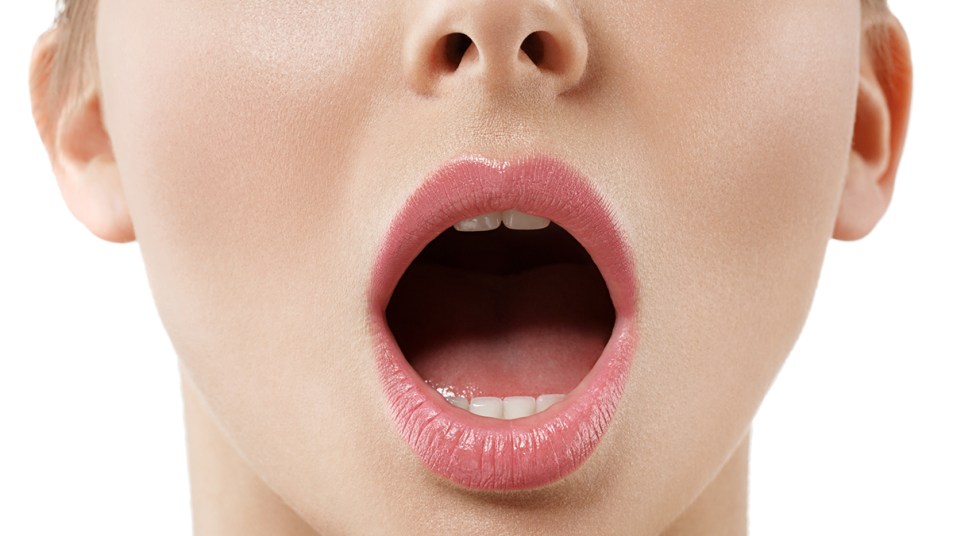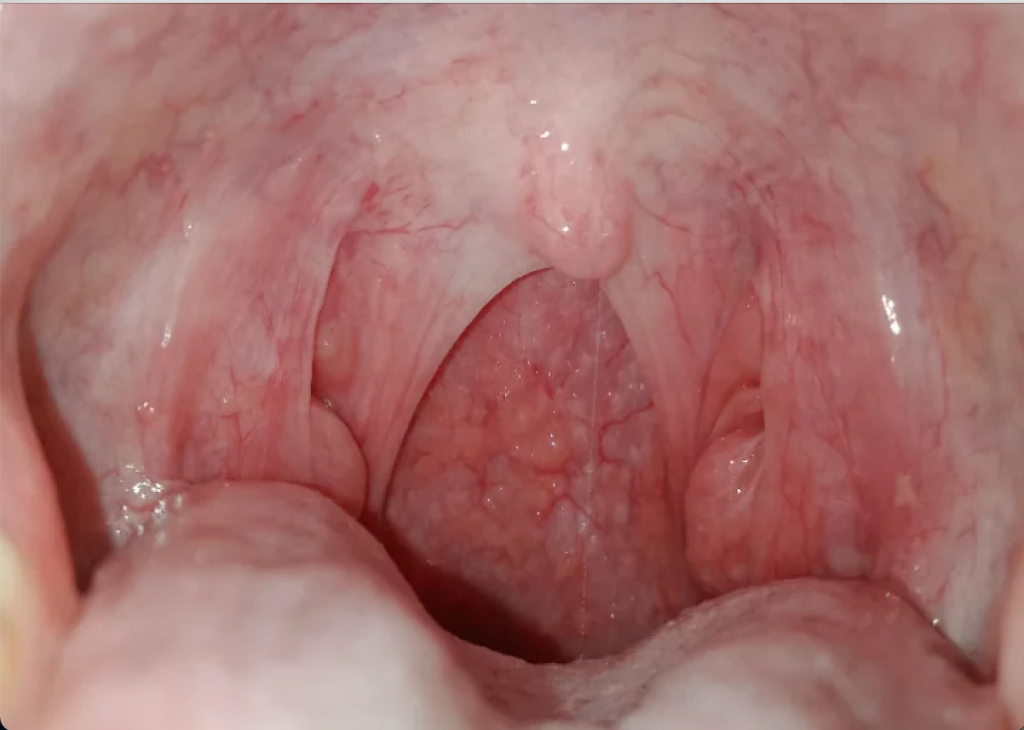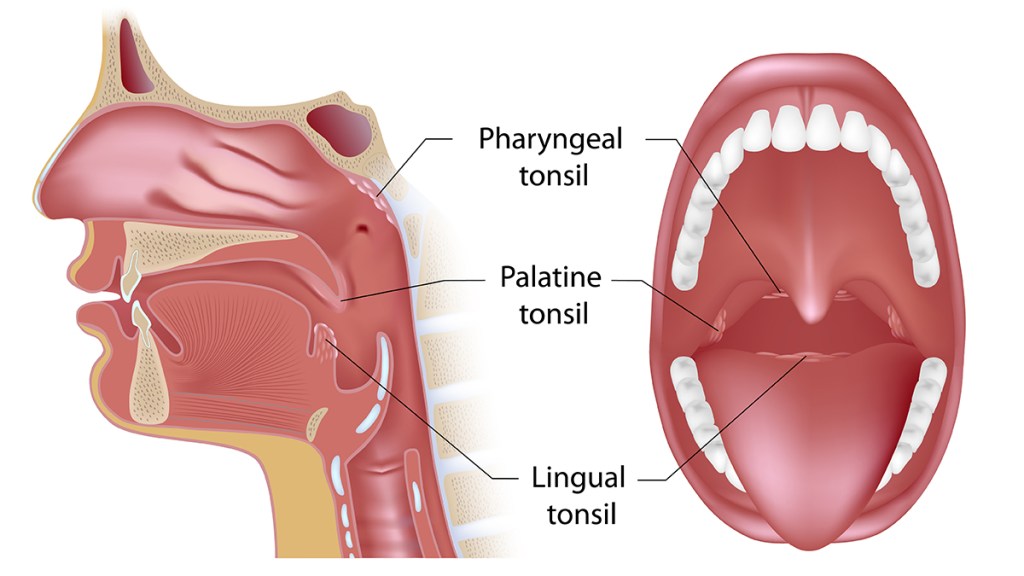Do You Have Bumps At The Back of Your Throat? They Could Signal Something Dangerous
'Cobblestone throat' is often the first sign of silent acid reflux, which can lead to cancer

Maybe your throat is a little sore. Or perhaps you sense a lot of mucus in the back of your throat and find yourself clearing it constantly by coughing. So you decide to take a look in the mirror and see what the heck is back there. It’s then you see a multitude of little bumps…almost like a vertical cobblestone street. You’ve got a case of cobblestone throat.
Questions run through your mind: Could it be cancer? Should I schedule an appointment with my doctor immediately? Here’s what you need to know before you hit the panic button — or ignore a potential health issue.
What is cobblestone throat?

To check your own throat, you might want to sit in front of a lighted mirror (magnifying if you have it), open wide and take a look. If you have cobblestone throat, you’ll see a bunch of small bumps in the center of your upper throat, or the pharynx. The bumps are caused by mucus and tissue that arises in response to inflammation caused by an irritant, explains Kelvin Fernandez, MD, an internist at Newark Beth Israel Medical Center and healthcare educator at Ace Med Boards.
“Cobblestone throat is not a disease itself, but a symptom that indicates some type of underlying condition. It is a response, typically an inflammatory one, to any one of a variety of irritants,” says Dr. Fernandez. A physician can see cobblestone throat anywhere on the back of the throat during a throat examination, and you likely can see the telltale pebble-like bumps when looking at the back of your throat in the mirror.
What does cobblestone throat feel like?
Depending on the cause, your throat might feel scratchy, sore or even so uncomfortable that it’s tough to swallow. Talking may also be painful or all those tiny bumps might resemble the sensation of having something stuck in your throat, or as though something has scratched the back of your throat.
What causes cobblestone throat?
When we’re healthy, our bodies are constantly making mucus to trap any nasty germ and foreign particles like smoke or other irritants we might breathe in. “Mucus is like your body’s own inbuilt cleaning service and keeps the air we breathe moist and our nasal passages clean and healthy,” explains Dr. Fernandez.
The bumps on your throat appear when your tonsils and adenoids (the soft tissue high in your nasal cavity behind your nose) are irritated. As a reaction to the irritation, your body’s immune system triggers a response in the form of ramped up mucus production.

That extra mucus is thicker than normal to trap germs, but it also will trickle down your throat, causing postnasal drip, the most common culprit for getting the back of the throat to puff up and look somewhat like a cobblestone street. Postnasal drip can be caused by everything from a lingering tickle at the back of the throat after the flu to strep throat or even seasonal allergies.
A night of heavy smoking, cold, dry air, certain medications or even gastroesophageal reflux disease (GERD) — where stomach acids come back up the throat — can put you on the path to cobblestone throat. You also shouldn’t rule out stress as a factor, says Dr. Fernandez.
Although there isn’t a direct link, stress can trigger habits such as excessive throat clearing and poor hydration — both of which can contribute to a sore throat and ultimately that ramped up production of mucus that leads to cobblestone throat.
Is cobblestone throat dangerous?
While the inflammation of the throat isn’t dangerous in and of itself, if the cause is underlying acid reflux, it could lead to complications if left untreated. Silent reflux, also known as laryngopharyngeal reflux (LPR), is a condition in which stomach acid flows back up the esophagus (swallowing tube) into the larynx (voice box). Sometimes this stomach acid can flow up as high as the throat, causing inflammation. “When you have silent reflux with stomach acid that keeps moving up, over time your throat can become irritated, feeling and looking bumpy, just like those cobbled streets,” explains Dr. Fernandez.
LPR is known as silent reflux because it doesn’t cause that burning in your chest known as heartburn. Instead, LPR causes chronic vocal-cord irritation, bad breath, poor sleep — and cobblestone throat. LPR is on the rise: According to a study at the Northwestern University Feinberg School of Medicine in Chicago, doctor visits for this type of reflux increased by almost 500 percent in a recent 10-year period.
If this sneaky silent reflux isn’t resolved, it could stir up some long-term damage because the throat is simply not designed to handle that kind of acid attack. Esophagitis, inflammation of the esophagus, hoarseness and even loss of your voice from irritation, insomnia and sleep apnea are just a few possible effects of untreated LPR.
“Perhaps the scariest risk of unchecked LPR, or silent reflux, is the increased odds getting esophageal cancer,” says Dr. Fernandez, “which is why it’s important to not ignore cobblestone throat or any symptoms of LPR.” If you can’t pinpoint another cause for your cobblestone throat, you’ll want to head to your primary care physician so he can take a look.
Is cobblestone throat contagious?
Cobblestone throat itself is not contagious, according to Praveen Guntipalli, MD, an internist and medical director and owner of Sanjiva Medical Spa in Dallas, Texas. However, some of the things that trigger it, like the flu or a bacterial infection, can be contagious and can lead to others also developing cobblestone throat.
How is a cobblestone throat treated?

Here are some of the most effective remedies for eliminating the causes of cobblestone throat.
Sleep upright
Sleeping propped up, or even upright, using a pillow to support your neck and back can lessen the chance all that irritating mucus will pool in your throat, paving the way for cobblestones. Sleeping upright also will help keep stomach acids from rising up your esophagus and irritating the back of your throat.
Keep water handy
Proper hydration is absolutely crucial in the management of cobblestone throat. So says Fernandez, who likens hydration to a magic elixir that thins out the mucus lining the throat. “You can try sipping cups of warm water with honey, too.” In fact, a review in Pharmacognosy Research found that honey’s antimicrobial and anti-inflammatory properties can soothe an irritated throat.
Try nasal irrigation
Irrigation devices like neti pots use saline, or saltwater, solution to moisten nasal passages, easing irritation to reduce production of mucus that leads to cobblestone throat. These handy and inexpensive tools can be used daily or to treat congestion caused by cold, sinus issues and allergies — all common offenders of the throat that lead to extra mucus production and then cobblestone throat.
Get gargling
Dissolving and stirring ½ teaspoon of salt in an 8-ounce glass of warm water and gargling for a few minutes can ease the discomfort of your cobblestone throat. Indeed, research published in the Journal of the Indian Society of Pedodontics and Preventive Dentistry found that saltwater can wipe out viruses or bacteria from your mouth or throat that cause the overproduction of mucus.
Consider lozenges
Lozenges can indeed be beneficial for cobblestone throat, notes Dr. Fernandez. “Many lozenges contain soothing components like menthol, which has a cooling effect that’s great for soothing that feeling of a rough, bumpy throat that often comes with a cobblestone throat.” Honey plays a role here, too, as lozenges featuring this golden ingredient have been found to be an effective cough suppressant, easing irritation to slow down production of thick mucus that causes cobblestone throat.
Avoid these foods
Food and beverages can play a role in your comfort levels when dealing with cobblestone throat. Caffeine, for example, can be dehydrating, which could thicken that mucus, prolonging the duration of a cobblestone throat’s bumps and other symptoms. Also, spicy foods and acidic fruits might irritate the throat further or trigger heartburn, lengthening the amount of time a cobblestone throat lingers.
How long does cobblestone throat last?
Dr. Guntipalli says cobblestone throat typically resolves in a week or so, depending on the underlying cause. If it lasts longer, or worsens, you should contact your healthcare provider for help identifying the exact cause and recommended treatments.
This content is not a substitute for professional medical advice or diagnosis. Always consult your physician before pursuing any treatment plan.













